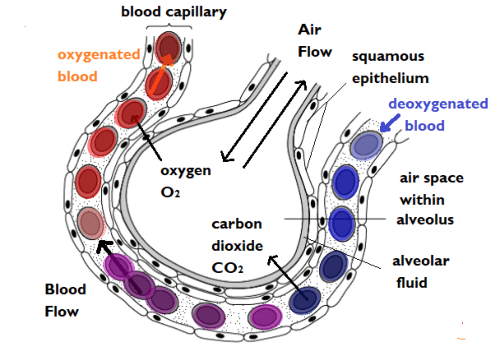9.01 Gas Exchange in Multicellular Organisms

1. Importance of Specialized Gas Exchange Surfaces in Multicellular Organisms
Reasons for Specialization
- Multicellular organisms require specialized gas exchange mechanisms because simple diffusion across outer surfaces is insufficient due to:
- Large Size:
- Increased Diffusion Distance: As organisms grow larger, the distance over which gases must diffuse from the environment to internal cells increases, making simple diffusion inefficient.
- High Oxygen Demand:
- Efficient Oxygen Supply: Metabolically active cells require a constant and adequate supply of oxygen, necessitating a highly efficient gas exchange system.
- Carbon Dioxide Expulsion:
- Maintaining pH Balance: Effective removal of carbon dioxide is crucial to prevent toxicity and maintain the organism’s internal pH balance.

Characteristics of Gas Exchange Surfaces
- Large Surface Area:
- Maximizes the area available for gas exchange, allowing more oxygen and carbon dioxide molecules to diffuse simultaneously.
- Thin Structure:
- Reduces the diffusion distance, facilitating faster and more efficient gas exchange.
- Moist Environment:
- Maintains gases in a dissolved state, enhancing their diffusion across membranes.
2. Gas Exchange in Humans
Primary Site of Gas Exchange
- Alveoli (Singular: Alveolus):
- Tiny air sacs located within the lungs where gas exchange occurs.

Structure and Distribution of Alveoli
- Extensive Surface Area:
- Total Surface Area: Approximately 70–75 square meters in adult humans. (the surface area of the base of a car is around 8 – 10 sq meters for example).
- Significance: A large surface area allows a high number of oxygen and carbon dioxide molecules to diffuse efficiently.
- High Density:
- Alveoli are densely packed in the lungs, ensuring that oxygen and carbon dioxide can be exchanged rapidly to meet the body’s metabolic needs.
Importance of Surface Area
- Oxygen Solubility:
- Oxygen has low solubility in water; thus, a large surface area is essential to facilitate a high diffusion rate necessary to supply the body with adequate oxygen.

3. Key Features of Alveoli for Efficient Gas Exchange
Large Surface Area
- Purpose:
- Maximizes the volume of gas that can be exchanged at any given time, supporting high metabolic rates.
Thin Walls
- Composition:
- Consist of a single layer of epithelial cells.
- Function:
- Minimizes the distance gases must travel, enhancing the rate of diffusion.
Moist Lining
- Role:
- Dissolves oxygen and carbon dioxide, which is essential for their diffusion across the alveolar and capillary membranes.
Rich Blood Supply
- Capillary Network:
- A dense network of capillaries surrounds each alveolus.
- Maintaining Concentration Gradients:
- Oxygen Transport: Capillaries rapidly transport oxygen away from the alveoli to the body’s tissues.
- Carbon Dioxide Removal: Brings carbon dioxide from tissues to the alveolar surface for exhalation.
Additional Notes
- Respiratory Membrane:
- The barrier between alveolar air and blood in capillaries, typically around 0.5 micrometers thick, facilitating rapid gas diffusion.
- Ventilation-Perfusion Ratio:
- The matching of air flow (ventilation) and blood flow (perfusion) in the lungs is crucial for optimal gas exchange efficiency.
- Regulation of Gas Exchange:
- Controlled by respiratory rate and depth, influenced by factors such as carbon dioxide levels, pH, and oxygen availability.